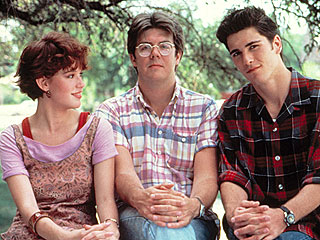Nine years on from the legendary filmmaker’s untimely passing, two Quench contributors consider whether his classic works, which focused largely on the trials and tribulations of adolescence, are still relevant for teenage audiences today:
“You know, as long as I’ve known him, everything works for him: school, parents, future“ – Ferris Bueller’s Day Off
From The Breakfast Club to Sixteen Candles, Hughes’ classic teenage ´¼ülms reveal how these three notions become so important in the mind of a young teen.┬á He shares their desires, their fantasies, but, most importantly, the self-doubt that they inevitably come across. What is even more surprising about John Hughes’ cult ´¼ülms is how they are still so relevant today. These ´¼ülms capture teenager feelings- how they give importance to social status, to the image they portray of themselves, and to what they aspire to become. All of these aspects are still extremely present in today’s society, where young teens believe in the need to build a certain identity.
This is what Hughes wishes to stress- how high school life leads boys and girls into questioning who they are and who they aspire to be. His characters seek to discover their identity while experiencing uncertainty and doubt. In The Breakfast Club, Hughes presents the theme of personality from the beginning as the teens are asked to answer one simple question during detention: who do you think you are? Each one of them attempts to answer it, yet fails to do so, making the audience realise that the question is being answered throughout the ´¼ülm. There is “a brain, and an athlete, and a basket case, a princess, and a criminal.” Hughes unleashes the stereotypes of high school, but also reveals how the borders between each character blurs. while opinions of others are not taken into account. When not worrying about what their friends might think, they come to question their identity and learn life lessons. Although they leave in separate ways, each character emerges as a more mature individual. Hughes’ portrait of high school through The Breakfast Club embodies this universal idea of identity and how it is still relatable in today’s society. Only the inescapable 1980s cinematic style would lead an audience to believe that it is 30 years old.
In Ferris Bueller’s Day Off, Hughes also captures teenage fantasies and dreams about crossing boundaries. For a day, the main characters wish to accept a challenge, to become rebels while doing the things they are not allowed to do. The ´¼ülm exposes a strong American 1980s style, yet shares the same recurrent theme concerning teenage feelings about the future, parenting, and identity. Hughes. likewise, succeeds in portraying youth fantasy through Sixteen Candles and Weird Science, as he embodies teenage feelings through his characters. Samantha (Sixteen Candles), Gary and Wyatt (Weird Science) all undergo insecurities and aspire to make their fantasies reality. Gaining con´¼üdence becomes a must in each scenario, as the teens experience the social pressure of high school.
In each of these ´¼ülms, Hughes pictures the life of teenagers through clich├®s, stereotypes and recurrent themes that disclose a modern input of teenage feelings. He manages to timelessly capture the insecurities, fantasies, and doubts of young adults. The contemporary vision of John Hughes still embodies all of these attributes today, where overcoming our fears and confronting our uncertainties becomes part of the process of growing up.
By Leanna Reeves
Hughes’ 1984 coming-of-age┬á film Sixteen Candles stars anxious Samantha, who faces her sixteenth birthday with dread. Samantha pines for the popular older boy Jake, but worries her chastity will be a turnoff for the senior. In the meantime, Samantha must continually reject the affection of Ted, who is the nerdy boy at school, and the only one who seems to be interested in her. You know, the usual obstacles that teenagers face – lustful crushes followed by raging hormones, dysfunctional family members and friendship betrayals.
However, the movie has many flaws such as racist, homophobic and misogynistic remarks, which are all presented as hilarious in the film. The foreign exchange student Long Duk Dong is a walking stereotype of Asian culture and his name is usually accompanied by the sound of a gong in the film. The characters in the film also use homophobic slurs against each other without thinking, and the male characters are an embodiment of toxic masculinity. It gets worse, as the film glamourizes date rape, when Jake’s girlfriend Caroline, who is immensely drunk, is handed over to Ted, who is told by Jake to “have fun with her”. We later find out that Ted and Caroline have sex, but Caroline does not remember much, making it non-consensual. Quite a different view of the movie which I once thought was ÔÇÿgreat’.
Another classic, The Breakfast Club, depicts the social pressures placed on teenagers throughout high school. The film’s plot involves five high school students from different social cliques, who endure a Saturday detention under the rule of a megalomaniac principal (Paul Gleason). The group includes the ÔÇÿcriminal’ John Bender (Judd Nelson), the ÔÇÿprincess’ Claire Standish (Molly Ringwald), the ÔÇÿbrain’ Brian Johnson (Anthony Michael Hall), the ÔÇÿathlete’ Andrew Clark (Emilio Estevez) and the ÔÇÿbasket case’ Allison Reynolds (Ally Sheedy).
In this film, Hughes presented a raw and dark image of adolescence, confronting physical abuse and bullying, as John’s father burns him with a cigar, before Principal Vernon threatens to “beat the s***” out of John. However, the film also contains multiple homophobic slurs, and John sexually harasses Claire throughout the film, yet it is depicted as him just being his antisocial self. John torments Claire about her virginity and he shockingly puts his face in Claire’s crotch when he is hiding under the table, forcing her to physically resist him.
Ferris Bueller’s Day Off┬á is about a teenage anomaly who is skilful at skiving classes and getting away with it – this truly only happens in the movies.┬á Ferris intends to make one last getaway before graduation and so he calls in sick, ‘borrows’ a cherry-red Ferrari and embarks on a one-day journey in Chicago. The movie’s central notion of carpe diem emphasises the importance of taking chances and carving your own path. For example, Cameron Frye (Alan Ruck), Ferris’s best friend, is introduced as an insecure worrier who borrows a car, goes to a Cubs game and eats pancreas, which is then followed by an emotional breakdown. Despite this unconventional and almost unbelievable trail of events, Hughes wanted to symbolise the rebellion against rules and order as well as the foolishness of adults. The film embodies the typical timeless qualities of being a teenager such as teen-angst, rebellion and hatred of gym class, whilst retaining its unique 80s aesthetic.
Hughes stunned Hollywood with his films, making him known as the 80s auteur of teen-angst as he conveyed the isolation and anger adolescents feel. It can be argued, however, that Hughes films are not a realistic depiction of teenage life today.┬á I mean, where would we find a Ferrari to ÔÇÿborrow’ and get away with it? Also, the racism, homophobia and sexual misconduct presented in his films would most likely be met with outrage, rather than laughter, in the contemporary political climate, if it was released today. In my opinion, this does not make Hughes films timeless – rather, they raise questions as to why such grotesque issues were ever laughable, rather than being frowned upon.
By Haleema Khan



